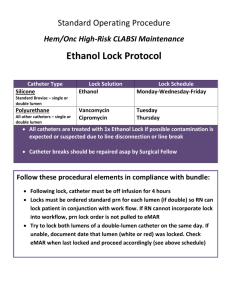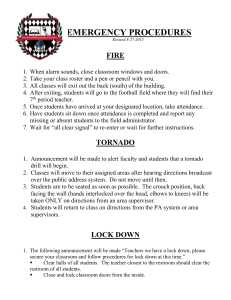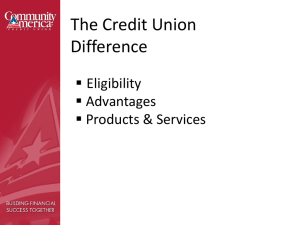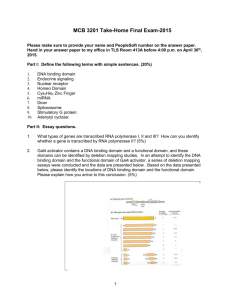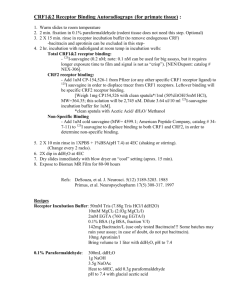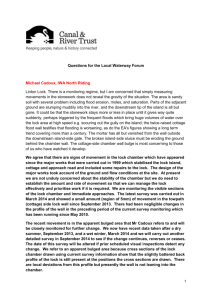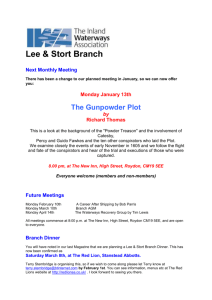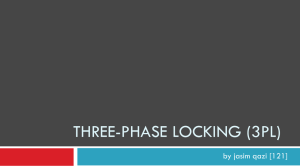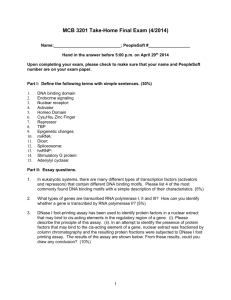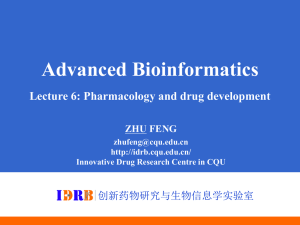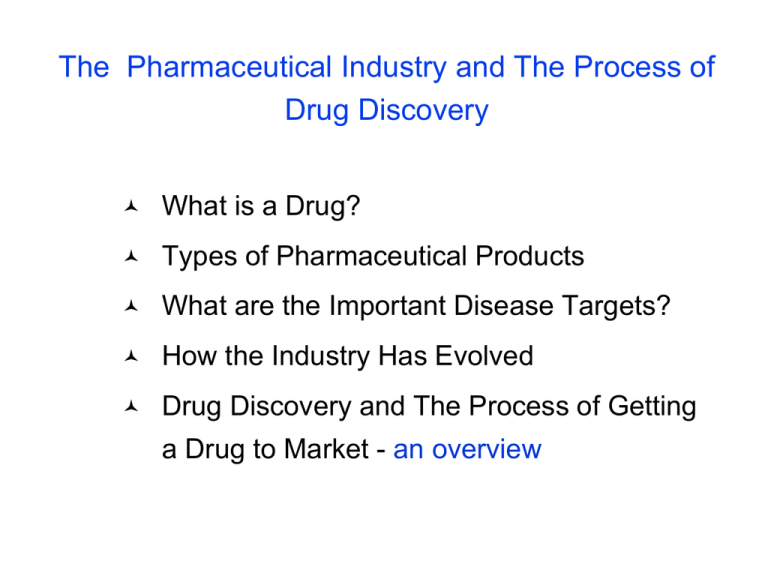
The Pharmaceutical Industry and The Process of
Drug Discovery
What is a Drug?
Types of Pharmaceutical Products
What are the Important Disease Targets?
How the Industry Has Evolved
Drug Discovery and The Process of Getting
a Drug to Market - an overview
What is a drug?
“A Chemical Substance that Interacts with a Living
System and Produces a Biological Response”
What is a drug?
“A Chemical Substance that Interacts with a Living
System and Produces a Biological Response”
What is a drug?
“A Chemical Substance that Interacts with a Living
System and Produces a Biological Response”
Good and Bad Drugs?
Safe Drugs?
What is a drug?
“A Chemical Substance that Interacts with a Living
System and Produces a Biological Response”
Good and Bad Drugs?
Safe Drugs?
Morphine (bad?) vs. penicillin (good?)
Curare vs. paracetamol
Classification of Drug Types
Ethical drugs
Generic drugs (no longer under patent)
“Prescription Only” vs “Over the Counter”
“Off Label” applications
Orphan drugs
Biotechnology products
Counterfeit drugs
Street drugs!
What criteria MUST new drugs meet?
Drugs must address a new need or
provide a significant “added benefit” over
an existing medicine
Drugs must also meet five criteria:
Must be safe, effective, of high quality
…cost effective (1980s)
……….affordable (1990s)
……………REALLY affordable (2000+)
Major Therapeutic Targets
Infectious disease – anti-infectives
Anti-bacterial, anti-viral, anti-parasitic drugs
Metabolic disease
cancer, cardiovascular, diabetes,
inflammation, high blood pressure,
neurological disease, pain
Other aspects of health care
Hormonal treatments, contraception,
vaccines, immunosuppresents, anaesthetics,
nutraceuticals, “life style” drugs
A History of the Pharmaceutical Industry
The early days - Egyptians, Greeks, Arabs, China, India
Plant-derived medicines
morphine (1805), quinine (1819), colchicine (1820), pilocarpine (1875)
Hormones
insulin (1921), estradiol (1929), testosterone (1931), “the pill” (1960)
Antibiotics, Psychoactive drugs (post-1945 to 1960’s)
penicillin (1944), streptomycin (1944), valium (1963)
Treatment of metabolic disorders (1960’s to current day)
Ventolin (1969), Lipitor (1997), Viagra (1998), Avandia (1999), Vioxx
(1999), Gleevec (2001)
Search for gene therapies (1990), stem cell-based therapies
Stem-cell replacement of a trachea (2008)
Some Important Events
American Civil War
Legislation – UK Cruelty to Animals Act (1876); US Federal Food
and Drug Act (1906)
World War 1 - Development of UK regulatory rules
World War 2 – antibiotics
Vaccines – Smallpox: Jenner (1796) – eradicated in 1977
Thalidomide (1960) – report adverse drug reactions
AIDS (1980s) – fast track approval, “buyer power”
Viagra (1998)
Tamiflu – H1N1 (swine flu) pandemic (2009)
NICE (1999) – the affordability factor
Vioxx – anti-inflammatory – 1999-2004 due to litigation
Avandia – Type 2 (non-insulin dependent) diabetes - 1999-2010
also due to litigation
How do drugs work?
The Biological Target - enzyme or receptor
Where is the target - part of “us” or elsewhere
Paul Ehrlich, Nobel Prize 1908, salvarsan;
blood-brain barrier; “Lock and Key”
hypothesis; chemotherapy and “magic bullet”
The Lock - Active Site of
Enzyme/Receptor
The Key - the Drug
The “Lock and Key” analogy
Key
Lock
Binding
Here the KEY is the natural substrate
Binding of the KEY to the LOCK (an enzyme
or a receptor) then causes a response – a
shape change in the protein/receptor
The “Lock and Key” analogy
Key
Lock
Binding
Biological
Response
Here the KEY is the natural substrate
Binding of the KEY to the LOCK (an enzyme
or a receptor) then causes a response – a
shape change in the protein/receptor
But when an effective drug is present
Biological response
is altered OR shut down
vs.
Binding of Drug
is preferred
Drug may bind preferentially to the “active site”
Antagonist – binds and BLOCKS
Agonist – binds and ACTIVATES
Partial agonist – induces a partial response
Who discovers drugs? Doctors?
Identify biological target - biology
Prioritise/ validate target – pharmacology and
chemistry
Identify and optimise lead molecules –
chemistry/pharmacology
Preclinical studies – chemistry/pharmacology/
toxicology
Formulation - pharmaceutical sciences
Clinical evaluation – medicine
Manufacture - chemical engineering
Getting a drug to market
Disease target - possible drug candidates
Pre-clinical testing; R&D (1-3 yrs)
Toxicology, “ADME”
Clinical R&D (2-10 yrs; Av. 5yrs)
Phase 1 – healthy volunteers
Phase 2 – small patient group
Phase 3 – larger patient group
Regulatory approval (2-10(!) yrs)
Market
Phase 4 – long term monitoring
The Gamble - wastage and timescale
For EACH DRUG approved, an average of 7500
compounds will have been made
Of this 7500, an average of 21 will be tested for
subacute toxicology, 6.5 will be tested in humans and
2.5 will reach Phase 3 – 1 then gets to market………
Entire process takes on average 12 years
Costs $138M (1975); $800M (2000); $1.6Bn (2008)
Development costs do NOT include pre-launch
marketing which can DOUBLE costs
The “Pay Off”……to the companies
Typical R&D budget: 33% R and 67%D
R&D = 15 to 25 % of sales turnover
Patent protection – 20 years from filing
On average, 11yrs. of productive market life
Losec – $2.7Bn in 1998; Nexium (single
enantiomer) $7.7Bn in 2008
Lipitor - $1Bn in 1998; $13.8Bn in 2008
The “Pay Off”…….to us
Massive contributions to health, quality of life,
reduced child mortality, life expectancy
Vaccines have eradicated major disease –
smallpox; vaccines for malaria and pneumonia
soon……..?
But costs and accessibility to healthcare are
becoming major social and geopolitical issues
And, is there something seedy about making
money out of illness?
What will happen into the future?
The Companies in 2010
Total Sales $billions
1
2
3
4
5
6
7
8
9
10
Johnson & Johnson
Pfizer
Roche
GSK
Novartis
Sanofi-Aventis
AstraZeneca
Abbott
Merck
Bayer
61.9
50.0
47.4
45.8
44.3
42.0
32.8
30.8
27.4
22.3
Major Therapeutic Targets
CNS
Metabolic
Cardiovascular
Anti-infectives
Respiratory
Gentio-urinary
Musculoskeletal
Oncology
Top 10 Therapies - sales in 2008 (US$Bn)
2008 sales
% share
Oncology agents
45.8
6.4
Lipid regulators
34.2
4.8
Respiratory agents
30.7
4.3
Acid pump inhibitors
26.7
3.8
Antidiabetics
26.0
3.7
Antipsychotics
22.4
3.1
Angiotensin antagonists
21.6
3.0
Antidepressants
20.4
2.9
US$227.8Bn
32.1%
What makes a good drug?
Lipinski's rules (Chris Lipinski – 1997)
In general, an orally active drug will meet most of the
following:
•
Not more than 5 hydrogen bond donors (nitrogen or
oxygen atoms with one or more hydrogen atoms)
•
Not more than 10 hydrogen bond acceptors (nitrogen or
oxygen atoms)
•
A molecular weight under 500 daltons
•
An octanol-water partition coefficient log P of less than 5
•
http://www.molinspiration.com/cgi-bin/properties
Case Study
Cimetidine (Tagamet)
1979
H2 blocker; anti-ulcer/heartburn
US
1976
UK
1983 First drug to reach $1Bn
1974
Cleared for OTC in 1995
1972
1970
1968
1966
1964
Programme
starts
Into volunteers
Cimetidine
Burimamide
First lead
What is a drug?
“A Chemical Substance that Interacts with a Living
System and Produces a Biological Response”



